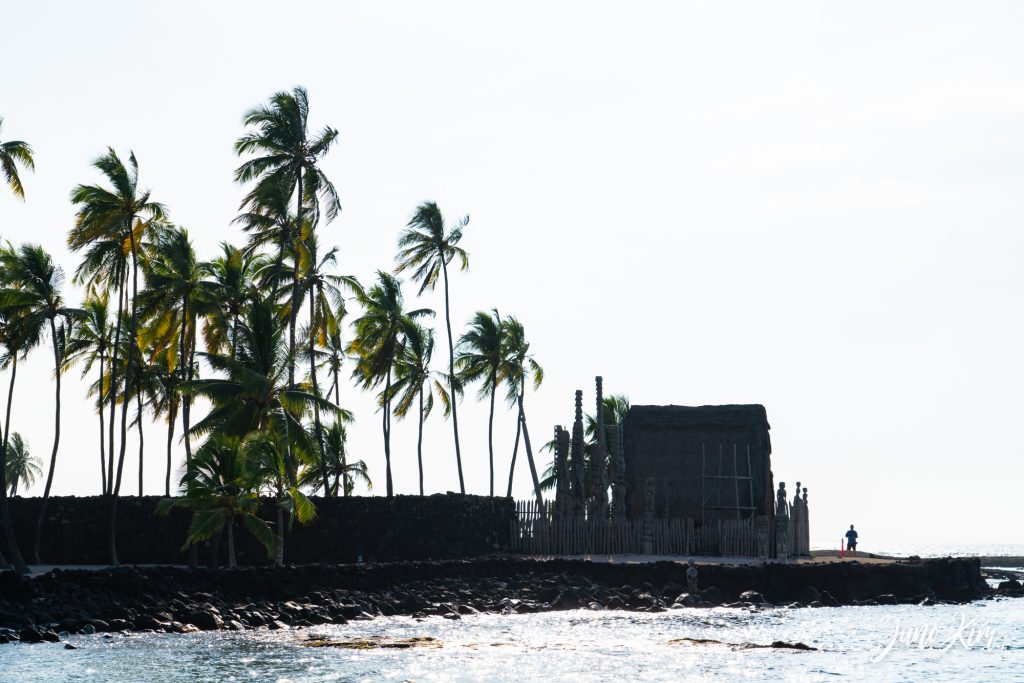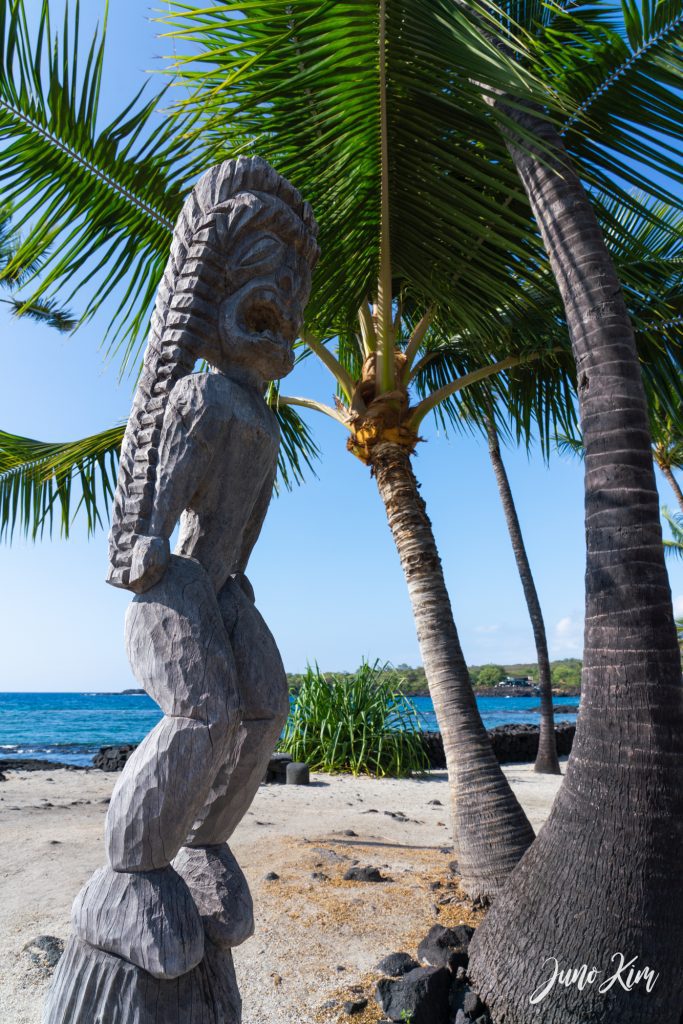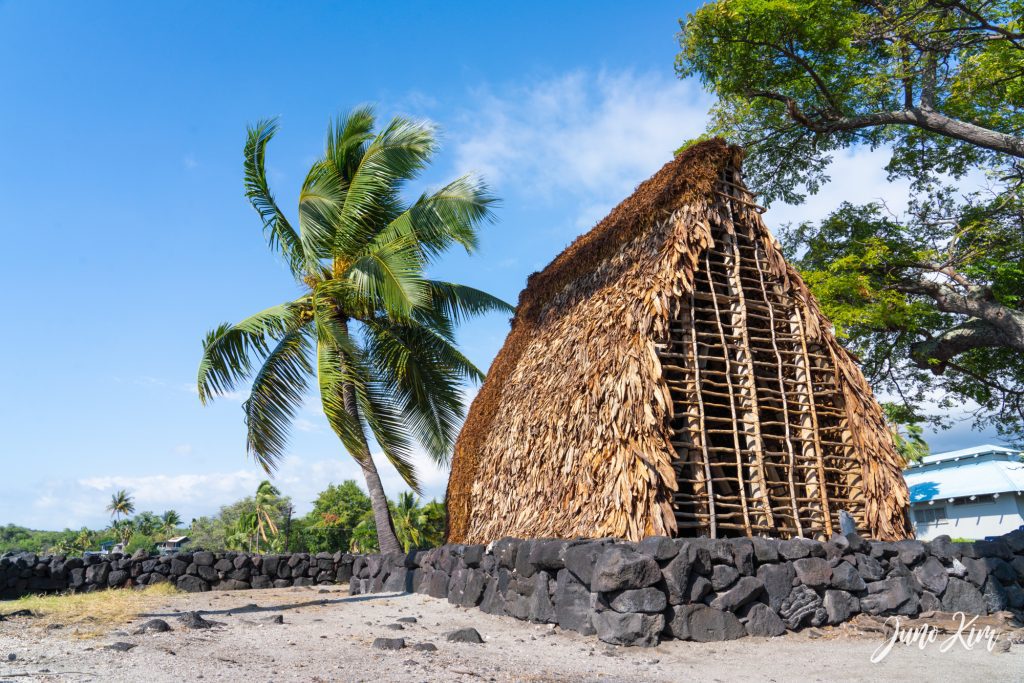Imagine a place of refuge…
At one of the most beautiful places on the island, a place of refuge (Puʻuhonua) exists. In the days of kapu (meaning forbidden, the ancient Hawaiian code of conduct of laws), imagine you have just broken a sacred law that’s punishable by death. What do you do? The only chance of survival is to reach Puʻuhonua. If you reached the Puʻuhonua, you would be pardoned by Kahuna and given a second chance at life. Now you can visit the sites at Puʻuhonua o Hōnaunau National Historical Park in Hawai’i Island. This is a place of refuge and royal grounds south of Kealakekua Bay.

Cultural travel is important
Experiencing different cultures and history is perhaps my favorite way of exploring a destination. Since we relocated to Alaska, we visited Hawai’i several times. I enjoyed our time in the volcanoes, at the beaches, eating delicious food, and exploring rainforests, but I was always drawn to the cultural aspects of Hawai’i. This time, we dove a little bit deep into Hawai’i’s rich history.
Puʻuhonua o Hōnaunau National Historical Park in Hawai’i Island, designated as a National Historical Park in 1961, is located in the most beautiful place. Pristine waters, amazing view of the ocean and nearby islands, palm trees, and nice and gentle sea breeze… You can see why it has such an important cultural significance.
The visit starts with a ranger talk, if you’re there in time for their 11:30am daily presentation. I highly recommend attending the presentation or at least see the national park film playing at the amphitheater.
The Puʻuhonua

The only preserved Pu’uhonua in Hawai’i, this site is an incredible window into ancient Hawaii’s cultural and spiritual traditions. Ancient Hawai’i had a system of laws. Certain people, places, things, and times were sacred — they were kapu, or forbidden. For example, women couldn’t eat with men. A commoner wasn’t allowed to look chiefs in the eye. Any breaking of kapu disturbed the stability of society, and the punishment was often death. The only chance of survival was to reach within the walls of the Puʻuhonua. That wasn’t the only purpose of the Puʻuhonua. In the wartime, families of warriors could seek refuge and safety within the walls and be assured to return home regardless of the outcome of the war. Although many pu’uhonua existed in ancient Hawaiʻi, Pu’uhonua o Hōnaunau is the best preserved and most dramatic given the extent of its monumental architecture. It’s interesting to see that the black lava rock shoreline hindered those who broke kapu from approaching by sea.
Things to See
- Hale o Keawe: A sacred heiau (temple) and royal mausoleum with a variety kiʻi (wooden images)
- ʻĀleʻaleʻa: This structure may have been the principal heiau before Hale o Keawe was built
- Keōua Stone: According to local tradition, this was a favorite resting place of Keōua, a high chief
- Ancient Heiau Site: Only remnants remain of this ancient heiau, which is among the oldest structures in the park
The Royal Grounds

The historic site includes the Hale o Keawe Temple. Overlooking the scenic Kealakekua Bay, the temple is a sacred site. The site is guarded by carved wooden kiʻi (statue), symbolizing Hawaiian gods. It was built in the 1650s to house the bones of Keawe-‘Ī-kekahi-ali ‘i-o-ka-moku, King of Hawai‘i Island. Ancient Hawaiians believed that a person’s spiritual essence (mana) resides within their bones (iwi). After Keawe’s death, 22 others were rested in the same temple. The remains were moved and Hale o Keawe was reconstructed to help bring Hawaiian history to life. The Royal Grounds include the Great Wall, standing 12 feet high and 18 feet thick.
Things to see
- Royal Ponds: Anchialine (brackish water) pools used to hold fish for the aliʻi. Today, invasive tilapia make circular nests in the sandy bottom.
- Kōnane Papamū: A stone papamū (playing surface) for playing kōnane (Hawaiian checkers).
- Keoneʻele Cove: A protected cove used as a canoe landing for the aliʻi. Today, at times, honu (sea turtles) rest on the shoreline.
- The Great Wall: A 400-year-old wall constructed using uhau humu pohaku (dry-set masonry) with no mortar between rocks.
- Canoe Hālau: A-frame structures used to store canoes and provide shade for artisans to work.
- Kānoa: Bowls carved into rock that may have been used for dying kapa (bark cloth), tanning fishing nets, or pounding ʻawa root to make a ceremonial drink.





How to Visit Puʻuhonua o Hōnaunau National Historical Park
Self-Guided Walking Tour
Take your time walking around the Royal Ground, passing the Great Wall. You’ll reach the Pu’uhonua, where people found their refuge. The self-guided walking tour is about half a mile long. The terrain is a mixture of crushed coral sand and lava rock.
Audio Tour on the Official NPS App
Enhance your visit by doing an audio tour of the park. Download the Official NPS app to access the recordings. This tour follows the same route as the self-guided walking tour.